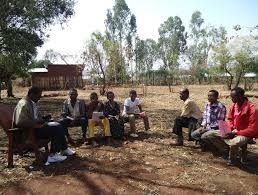Ethiopians have a longstanding culture of planting, preserving and conserving trees around the sites and premises of religious institutions, in their places and surroundings; as well as at public spaces.
Particularly, elders and religious fathers viewing trees as sacred resources that have their own significant benefits, and passing resolution that cutting or destroying trees is a taboo act that leads to a certain punishments, have played an important roles in terms of implanting the culture of conserving nature within the mind of the people, developing the culture and deepening attachments between the people and the environment thereby to maintain a balanced ecosystem.
The Gedeo people, the Aba Gedas and the “Kalus” who have a long-standing tradition of conserving trees, among others can be mentioned as models in strengthening community environment conservation efforts.
As a result, though now it turned out to be a thing of the past, owing to the age old trends of the society, Ethiopia was a country once covered by various types of trees both native and non-native species, studies indicate. Unfortunately, mainly over the past five or six decades, the forest coverage of the country has been dwindling alarmingly for various reasons including human incursions and agricultural expansion plus for fuel.
In fact, since the past twenty plus years, huge seedling planting activities have been carried out to restore degraded lands and recuperate the country’s forest coverage even though the outcome has not been as expected.
As part of these efforts- to rehabilitate degraded lands, increase country’s forest coverage, fight desertification thereby mitigate the undesirable impacts of climate change, massive tree planting works are ongoing at nationwide
“The Green Legacy Initiative” that was launched by the government in 2019 and it has reached its second phase by now, is bearing fruit.
The Initiative aside from enabling the planting of 25 billion tree saplings in four years’ time, it has revived Ethiopians’ tree planting tradition, gathered together millions of Ethiopians for the same purpose, created an opportunity to rekindle a sense of pride and inspired many to participate in the tree planting campaign.
The Ethiopian Herald approached North Shewa Zone Administration Kewot Woreda REDD++ Bureau Coordinator of the Amhara State Shamble Sharew over a phone to have his say regarding the spirit the initiative has created among Ethiopians. As to him, the initiative has brought communities together to work towards a common goal.
“Ethiopians from all walks of life, including farmers, students, and civil servants, took part in the tree planting campaign carried out in the last four years. This, in turn, has fostered a sense of community and solidarity and contributed significantly in terms of further cementing social cohesion. Responding to the plan to plant 500 million saplings, we are mobilizing the community and preparing 184 hectare of land for planting saplings,” he underlined.
According to him, the communities are well aware of the benefits of planting trees and its social and economic return; especially the high lander communities are eager of it and yearning for the commencement of the campaign. The Bureau is working with the community and stakeholders to hold productive sapling planting activity.
The Bureau is engaged in successive and effective awareness creation campaigns to reach out to the community at the grassroots level. The community is well informed about the purpose of the Green Legacy Initiative and its positive impact on the environment and mitigating the effects of climate change.
“Overall, we can say that the Green Legacy Initiative has been a successful campaign that unites Ethiopians irrespective of any differences and it has inspired a sense of pride among Ethiopians aside from contributing a lot in the efforts exerted to combat climate change and promote sustainable development.”
The initiative has also provided an opportunity for education and awareness-raising about the importance of trees and the environment. This, in turn, can promote a culture of environmental stewardship and sustainability.
In general, the Green Legacy Initiative has created a sense of pride among the community, benefiting both the older and new generations, through promoting a healthier environment, providing economic opportunities, preserving cultural heritage, and enhancing awareness about the environment, he concluded.
Civics and Ethical Education Teacher at Kewot woreda Chare Elementary School Habte Asmare for his part said that the initiative has a profound impact on the environment and also plays a significant role in promoting unity and harmony among Ethiopians.
“The initiative has encouraged the participation of people irrespective of any differences be it ethnicity, religion, gender, age or occupation as well as political stand. This, in turn has developed a sense of shared responsibility and ownership for the success of the initiative, and fostered a spirit of unity and collaboration among Ethiopians,” he opined.
The act of planting trees has a unifying effect, as it is a tangible way to contribute to a larger cause that benefits everyone. This has helped to break down barriers and promote understanding and cooperation across different groups, he remarked.
Apart from promoting unity and harmony, the Green Legacy Initiative has also positive impacts on the environment and the economy. The reforestation program has helped to combat deforestation and soil erosion, improve water quality, and provide habitat for wildlife. It has also created new opportunities for sustainable livelihoods, such as through the production of honey and other forest products.
The Green Legacy initiative was launched in 2019 by Prime Minister Abiy Ahmed, with the aim to rehabilitate the nation’s degraded lands, reduce the impacts of climate change and contribute to global efforts exerted to avert the change.
BY MENGISTEAB TESHOME
The Ethiopian Herald July 14/2023





